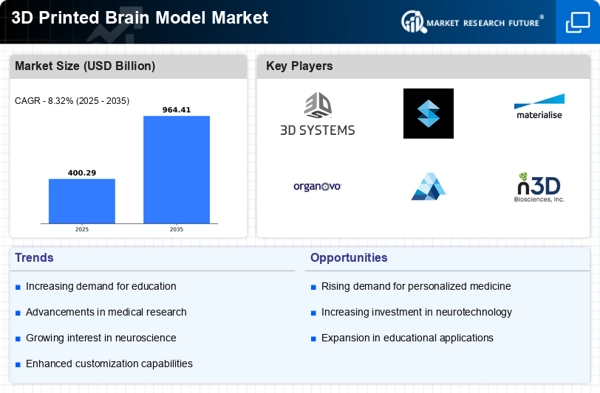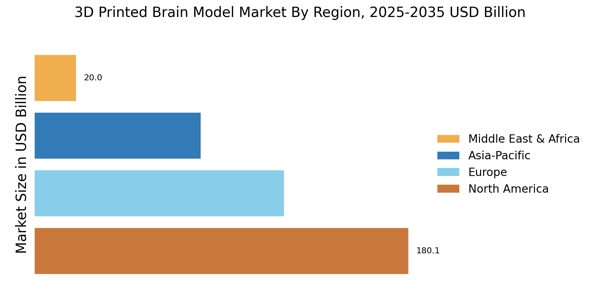The 3D Printed Brain Model Market is currently characterized by a dynamic competitive landscape, driven by advancements in technology and increasing demand for personalized medical solutions. Key players such as 3D Systems (US), Stratasys (US), and Materialise (BE) are at the forefront, each adopting distinct strategies to enhance their market presence. 3D Systems (US) focuses on innovation through continuous investment in R&D, aiming to develop more sophisticated bioprinting technologies. Stratasys (US), on the other hand, emphasizes strategic partnerships with educational institutions to foster research and development in medical applications, thereby enhancing its operational focus on educational and clinical markets. Materialise (BE) is leveraging its expertise in software solutions to integrate advanced analytics into its 3D printing processes, which collectively shapes a competitive environment that is increasingly reliant on technological advancements and collaborative efforts.
In terms of business tactics, companies are increasingly localizing manufacturing to reduce lead times and enhance supply chain efficiency. The market appears moderately fragmented, with several players vying for dominance, yet the collective influence of major companies is significant. This competitive structure allows for a diverse range of offerings, catering to various segments within the healthcare industry, from research institutions to clinical applications.
In August 2025, 3D Systems (US) announced a collaboration with a leading neuroscience research institute to develop a new line of 3D printed brain models aimed at enhancing surgical training. This strategic move is likely to bolster their position in the educational sector, providing cutting-edge resources for medical professionals and potentially increasing their market share in the training domain. The partnership underscores the importance of aligning product development with the needs of healthcare professionals, thereby enhancing the company's reputation as a leader in medical innovation.
In July 2025, Stratasys (US) launched a new bioprinter specifically designed for creating complex tissue structures, including brain models. This innovation is expected to significantly improve the accuracy and functionality of 3D printed models, positioning Stratasys as a key player in the bioprinting space. The introduction of this technology may not only attract new clients but also enhance existing relationships with research institutions focused on neurological studies, thereby reinforcing their market position.
In September 2025, Materialise (BE) expanded its software capabilities by integrating AI-driven analytics into its 3D printing workflow. This strategic enhancement is anticipated to streamline production processes and improve the precision of printed models, which is crucial for applications in neurosurgery. By adopting AI technologies, Materialise is likely to set a new standard in the industry, emphasizing the growing trend of digital transformation in the 3D printing sector.
As of October 2025, the competitive trends in the 3D Printed Brain Model Market are increasingly defined by digitalization, sustainability, and the integration of artificial intelligence. Strategic alliances among key players are shaping the landscape, fostering innovation and enhancing product offerings. Looking ahead, it appears that competitive differentiation will evolve from traditional price-based competition to a focus on technological innovation, supply chain reliability, and the ability to deliver customized solutions that meet the specific needs of healthcare providers.


















Leave a Comment